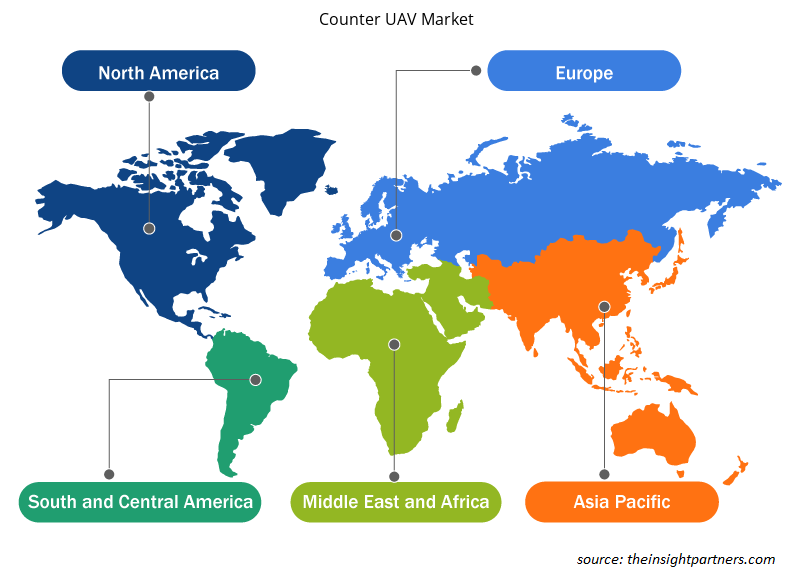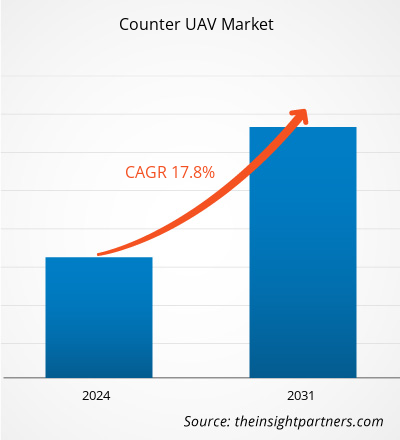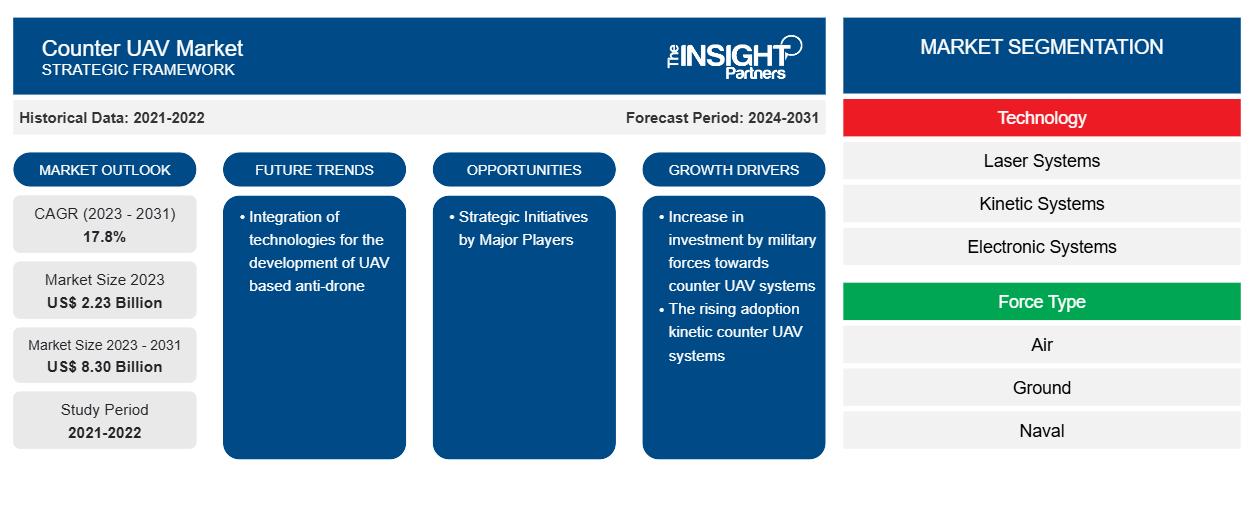Se prevé que el tamaño del mercado de vehículos aéreos no tripulados (UAV) alcance los 8.300 millones de dólares en 2031, frente a los 2.230 millones de dólares en 2023. Se espera que el mercado registre una CAGR del 17,8 % durante el período 2023-2031. Es probable que la integración de tecnologías para el desarrollo de sistemas antidrones basados en vehículos aéreos no tripulados siga siendo una tendencia clave en el mercado.
Análisis del mercado de vehículos aéreos no tripulados
Lockheed Martin Corporation, Thales Group, Northrop Grumman Corporation, Leonardo SpA y Rafael Advanced Defense Systems Ltd se encuentran entre los actores clave que operan en el mercado global de vehículos aéreos no tripulados . Los actores clave se enumeran teniendo en cuenta factores como los ingresos generales, la cartera actual de productos de vehículos aéreos no tripulados , el alcance geográfico, las iniciativas de mercado, la inversión en actualizaciones tecnológicas, las asociaciones y otras actividades relacionadas con el mercado.
Descripción general del mercado de vehículos aéreos no tripulados
Los principales actores en el ecosistema del mercado global de anti -UAV incluyen fabricantes de componentes, integradores de sistemas y usuarios finales , entre otros. Un radar de sistema anti- UAV se compone de varios componentes, como sensores y sistemas GPS , que son adquiridos por los fabricantes de sistemas de una enorme base de fabricantes de componentes. Estos fabricantes de componentes suministran las piezas base a los actores del mercado global de anti - UAV . Los integradores de sistemas son las empresas que se dedican a la fabricación de los sistemas anti-drones después de integrar cada componente. Algunos de los principales actores que operan en el mercado incluyen Raytheon Technologies Corporation, Rafael Advanced Defense Systems Ltd., Thales Group, Lockheed Martin Corporation e Israel Aerospace Industries Ltd., entre otros. El usuario final del mercado global de anti- UAV incluye fuerzas aéreas, terrestres y navales que se dedican a la defensa y seguridad nacional de los países. Las soluciones anti- UAV también han experimentado un aumento en la adopción por parte de las fuerzas de seguridad nacional para eventos y conciertos globales privados. Por lo tanto, el aumento del gasto militar de los países desarrollados y en desarrollo y sus crecientes inversiones para garantizar la seguridad de las fronteras terrestres y costeras contra los drones hostiles también están impulsando la alta adopción de soluciones para contrarrestar los UAV en todo el mundo.
Personalice este informe según sus necesidades
Obtendrá personalización en cualquier informe, sin cargo, incluidas partes de este informe o análisis a nivel de país, paquete de datos de Excel, así como también grandes ofertas y descuentos para empresas emergentes y universidades.
-
Obtenga las principales tendencias clave del mercado de este informe.Esta muestra GRATUITA incluirá análisis de datos, desde tendencias del mercado hasta estimaciones y pronósticos.
Factores impulsores y oportunidades del mercado de vehículos aéreos no tripulados
Aumento de la adopción de sistemas UAV de contador cinético
Los sistemas anti -UAV cinéticos son utilizados por los cuerpos militares de todo el mundo para derribar por completo un dron. Utilizan líneas de peso o redes anti-drones que generalmente se lanzan con la ayuda de aire comprimido u otro UAV . Estos dispositivos ayudan a capturar el dron, neutralizarlo o destruirlo. En ocasiones, se envían drones desconocidos dentro de los límites militares para estudiar el área o para vigilar de cerca el paradero del oponente. En tales casos, destruir el dron por completo garantiza una mayor seguridad para las fuerzas militares.
Algunas de las principales empresas que ofrecen sistemas anti-UAV cinéticos son KWESST Micro Systems Inc. y Zen Technologies Limited, entre otras. KWESST Micro Systems Inc. ofrece microdrones para la interdicción cinética de pequeños drones, incluidos enjambres, que pueden ser lanzados por soldados. Es un dron totalmente automático que ayuda a identificar drones, rastrearlos, cazarlos y neutralizarlos con tecnología cinética. Estos sistemas también cubren un alcance de 4 km. En octubre de 2021, la empresa anunció el desarrollo de un nuevo sistema anti-UAV en respuesta a la creciente amenaza de las municiones merodeadoras.UAV systems include KWESST Micro Systems Inc. and Zen Technologies Limited amongst others. KWESST Micro Systems Inc., offers micro-drone for kinetic interdiction of small drones, including swarms, that can be launched by soldiers. It is a fully automatic drone which helps in the dentification of drones, track, hunt and neutralize them with kinetic technology. These systems also cover a range of 4km. The company in October 2021, announced the development of new counter UAV system in response to the rapidly increasing threat of loitering munitions.
Iniciativas estratégicas de los principales actores
El aumento de los ataques terroristas y la inestabilidad política entre varios países desarrollados y en desarrollo está impulsando a las fuerzas de defensa y seguridad nacional a aumentar la adquisición de soluciones avanzadas, como sistemas de radar, sistemas de comunicación y tecnologías antidrones, entre otros. Por ejemplo, el Departamento de Defensa de los EE. UU., la Unión Europea y otras autoridades como el Ministerio de Defensa de la India han aumentado su gasto en la adquisición de antidrones a lo largo de los años. Esto está llevando a los fabricantes de UAV anti-antidrones a adoptar estrategias de crecimiento orgánico e inorgánico, como altas inversiones, ofertas de productos y expansión global, creando aún más oportunidades de crecimiento para el mercado global de UAV anti-antidrones.
Análisis de segmentación del informe de mercado de UAV de contraataque
Los segmentos clave que contribuyeron a la derivación del análisis del mercado de UAV contrarios son la tecnología, el tipo de fuerza, el tipo de producto, la configuración y los usuarios finales.
- Según la tecnología, el mercado de vehículos aéreos no tripulados se segmenta en sistemas láser, sistemas cinéticos y sistemas electrónicos. El segmento de sistemas electrónicos tuvo una mayor participación de mercado en 2023.
- Según el tipo de fuerza, el mercado de vehículos aéreos no tripulados se segmenta en aéreo, terrestre y naval. El segmento terrestre tuvo una mayor participación de mercado en 2023.
- Según el tipo de producto, el mercado de vehículos aéreos no tripulados de contraataque se segmenta en terrestres y portátiles. El segmento terrestre tuvo una mayor participación de mercado en 2023.
- Según la configuración, el mercado de vehículos aéreos no tripulados se divide en portátiles y fijos. El segmento fijo tuvo una mayor participación de mercado en 2023.
- Según la configuración, el mercado de vehículos aéreos no tripulados se clasifica en defensa y seguridad nacional. El segmento de defensa tuvo una mayor participación de mercado en 2023.
Análisis de la cuota de mercado de los UAV de contraataque por geografía
El alcance geográfico del informe de mercado de UAV de contador se divide principalmente en cuatro regiones: América del Norte, Europa, Asia Pacífico y resto del mundo.
En 2023, América del Norte dominó el mercado, seguida de Europa y la región de Asia Pacífico. Además, es probable que Asia Pacífico también experimente la CAGR más alta en los próximos años. Estados Unidos representó una participación importante en el mercado norteamericano de anti-UAV. Los sistemas anti-UAV, según el Departamento de Defensa de Estados Unidos (DOD), ayudan al ejército estadounidense a detectar y neutralizar drones hostiles o atacantes. Debido a su tamaño, material de construcción y altitud de vuelo, muchos UAS más pequeños son indetectables por los sistemas de defensa aérea típicos. Como resultado, el Departamento de Defensa de Estados Unidos (DOD) espera gastar al menos US$ 636 millones en investigación y desarrollo de anti-UAS (C-UAS) en el año fiscal 2022, así como al menos US$ 75 millones en la adquisición de C-UAS, un aumento de US$ 134 millones con respecto al año fiscal 2021. A medida que el Departamento de Defensa de Estados Unidos continúa desarrollando, comprando e implementando estas tecnologías, contribuye al crecimiento del mercado.
Perspectivas regionales del mercado de vehículos aéreos no tripulados
Los analistas de Insight Partners explicaron en detalle las tendencias y los factores regionales que influyen en el mercado de vehículos aéreos no tripulados durante el período de pronóstico. Esta sección también analiza los segmentos y la geografía del mercado de vehículos aéreos no tripulados no tripulados en América del Norte, Europa, Asia Pacífico, Oriente Medio y África, y América del Sur y Central.

- Obtenga datos regionales específicos para el mercado de vehículos aéreos no tripulados
Alcance del informe de mercado de vehículos aéreos no tripulados
| Atributo del informe | Detalles |
|---|---|
| Tamaño del mercado en 2023 | US$ 2,23 mil millones |
| Tamaño del mercado en 2031 | US$ 8.30 mil millones |
| CAGR global (2023 - 2031) | 17,8% |
| Datos históricos | 2021-2022 |
| Período de pronóstico | 2024-2031 |
| Segmentos cubiertos |
Por tecnología
|
| Regiones y países cubiertos |
América del norte
|
| Líderes del mercado y perfiles de empresas clave |
|
Densidad de actores del mercado: comprensión de su impacto en la dinámica empresarial
El mercado de vehículos aéreos no tripulados de contraataque está creciendo rápidamente, impulsado por la creciente demanda de los usuarios finales debido a factores como la evolución de las preferencias de los consumidores, los avances tecnológicos y una mayor conciencia de los beneficios del producto. A medida que aumenta la demanda, las empresas amplían sus ofertas, innovan para satisfacer las necesidades de los consumidores y aprovechan las tendencias emergentes, lo que impulsa aún más el crecimiento del mercado.
La densidad de actores del mercado se refiere a la distribución de las empresas o firmas que operan dentro de un mercado o industria en particular. Indica cuántos competidores (actores del mercado) están presentes en un espacio de mercado determinado en relación con su tamaño o valor total de mercado.
Las principales empresas que operan en el mercado de vehículos aéreos no tripulados son:
- Sistema de vigilancia Blighter Ltd.
- Dedrono
- Escudo para drones
- Industrias Aeroespaciales de Israel Ltd.
- Spa Leonardo
Descargo de responsabilidad : Las empresas enumeradas anteriormente no están clasificadas en ningún orden particular.

- Obtenga una descripción general de los principales actores clave del mercado de UAV de mostrador
Noticias y desarrollos recientes del mercado de vehículos aéreos no tripulados
El mercado de vehículos aéreos no tripulados se evalúa mediante la recopilación de datos cualitativos y cuantitativos a partir de una investigación primaria y secundaria, que incluye publicaciones corporativas importantes, datos de asociaciones y bases de datos. A continuación, se enumeran algunos de los avances en el mercado de vehículos aéreos no tripulados:
- Elbit Systems presenta una nueva y exclusiva capacidad de guerra electrónica (EW) en el Salón Aeronáutico de París como parte de su conjunto de EW unificado. La nueva capacidad se proporciona a través de los receptores de advertencia de radar (RWR) digitales, una parte del conjunto de EW de autoprotección aerotransportada de eficacia probada de Elbit, y permite la detección e identificación de drones, así como la localización de balizas de localización personal (PLB) de fuerzas terrestres y pilotos. (Fuente: Elbit Systems Ltd, comunicado de prensa, junio de 2023)
- Elbit Systems Ltd (NASDAQ:ESLT y TASE: ESLT) Elbit Systems anunció hoy que se le adjudicó un contrato por un valor aproximado de 55 millones de dólares para suministrar sistemas aéreos no tripulados (C-UAS) multicapa ReDrone Counter a los Países Bajos. El contrato se ejecutará durante un período de cuatro años. (Fuente: Elbit Systems Ltd, comunicado de prensa, agosto de 2023)
Informe sobre el mercado de vehículos aéreos no tripulados (UAV) de contraataque: cobertura y resultados
El informe “Tamaño y pronóstico del mercado de UAV de contraataque (2021-2031)” proporciona un análisis detallado del mercado que cubre las siguientes áreas:
- Tamaño del mercado de UAV de contraataque y pronóstico a nivel global, regional y nacional para todos los segmentos clave del mercado cubiertos bajo el alcance
- Contrarrestar las tendencias del mercado de vehículos aéreos no tripulados, así como la dinámica del mercado, como los impulsores, las restricciones y las oportunidades clave
- Análisis detallado de las cinco fuerzas de Porter
- Análisis del mercado de UAV de mostrador que abarca las tendencias clave del mercado, el marco global y regional, los principales actores, las regulaciones y los desarrollos recientes del mercado
- Análisis del panorama de la industria y de la competencia que abarca la concentración del mercado, el análisis de mapas de calor, los actores destacados y los desarrollos recientes para el mercado de UAV de contraataque
- Perfiles detallados de empresas
- Análisis histórico (2 años), año base, pronóstico (7 años) con CAGR
- Análisis PEST y FODA
- Tamaño del mercado, valor/volumen: global, regional y nacional
- Industria y panorama competitivo
- Conjunto de datos de Excel
Informes recientes
Testimonios
Razón para comprar
- Toma de decisiones informada
- Comprensión de la dinámica del mercado
- Análisis competitivo
- Información sobre clientes
- Pronósticos del mercado
- Mitigación de riesgos
- Planificación estratégica
- Justificación de la inversión
- Identificación de mercados emergentes
- Mejora de las estrategias de marketing
- Impulso de la eficiencia operativa
- Alineación con las tendencias regulatorias























 Obtenga una muestra gratuita para - Mercado de vehículos aéreos no tripulados de contrapeso
Obtenga una muestra gratuita para - Mercado de vehículos aéreos no tripulados de contrapeso